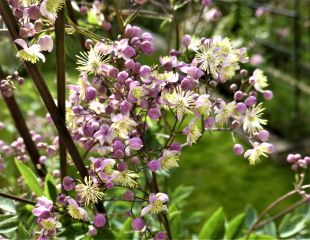
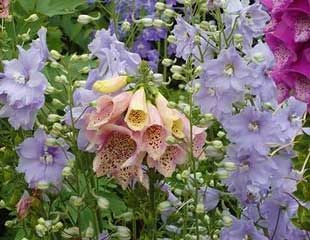
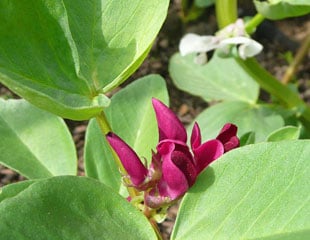
what to do in the garden in June
June is traditionally the time to plant out bedding plants which are so much part of an English summer. Even with our unpredictable weather by June it is safe to plant bedding with no risk of frost. Safe to say there is no risk of frost, but the weather can still surprise us, follow this link to see just how.
There are so many marvellous combinations to make a great bedding display, traditional pastels combining Pelargoniums, Lobelia and petunias; single planting schemes such as the French Marigolds, grasses and dahlias, even tumbling tomatoes, the list is endless. Hanging baskets and tubs dry out quickly and water retaining gel can be helpful to help retain moisture, combined with a mulch on the top if the planting arrangement is suitable.
Some bedding plants need a lot of attention, others are easier, it all depends how much time you have. When choosing bedding plants it is worth knowing which the best bedding plants to grow, as in which are easy and which are high maintenance, such as Ice plants, (Mesembryanthemum) Petunia, Verbena all of which need a deal of dead heading.
Easy to grow Bedding plants include Geranium (Pelargonium) Nasturtium, and schemes which combine some perennials such as Lavender and grasses with bedding plants. Gardening is a choice; for some it wouldn't be summer without baskets brimming with bedding, for others it's a chore too far.
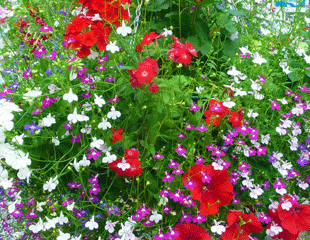
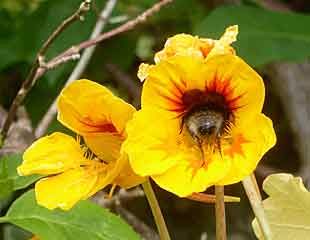
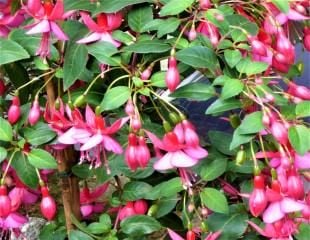
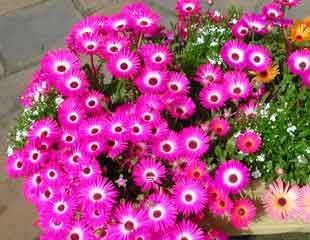
June in the garden
The Sunday Gardener "What to do in your garden in June" a series of 5 short videos or one composite video looking at gardening in June.
These videos cover lots of topics including planting out bedding plants, growing sweet peas, what to do in the veg plot, growing beans and different types of supports, Strawberries and botrytis, cutting back Aubretia, planting potatoes and potting on tomatoes.
Click here to view on YouTube.
Dead Head plants to keep them flowering
Dead heading both annual and perennial plants is always worthwhile. The removal of spent flowers from the plant prolongs the flowering season. Plants produce flowers as part of their reproductive process, from the flowers seed is formed. Once the seed is set the cycle is complete and a plant may reduce and eventually stop flowering. To keep plants flowering for as long as possible nip off the spent flowers.
This is especially true of all bedding type plants along with nipping the growth to make the plants bushy. Any plants you may want to self seed, such as Digitalis, or Aquilegia, do not dead head.
Dead heading is also suitable for perennial plants, although some plants will only flower once. Perennial plants suitable for dead heading include: Aster, Campanula, Delphinium and Digitalis (may produce lesser, second flush) Geum, Hemerocallis, Lavandula, Monarda, Nepeta, Phlox, Salvia, Scabious, Veronica, Rosa, Thalictrum. Not all will produce more flowers, but dead heading will improve the appearance of the plant once flowering has finished.
If you are growing sweet peas, dead heading is time well spent and is most important for sweet peas. If you have ever wondered why your sweet peas have stopped flowering early in the season, it may well be because there are too many spent flowers and seed pods on the plant. If you look closely, there will be seed pods on the plant where there should be more flowers.
In early June, especially in colder more exposed gardens, it is not too late to Chelsea Chop suitable perennials. Advice about the Chelsea chop and video.
Powdery mildew on Forget-me-nots. Late May/beginning of June is a good time to check on any remaining Forget-me-nots because by the tail end of their growing season they often suffer from powdery mildew. This can cause a problem for plants growing alongside the Forget-me-not as they can become contaminated with powdery mildew. Often Forget-me-nots are left in the ground to self seed. Be aware if they are a congested, (which can bring on powdery mildew,) this can easily spread to the plants around. One year I had to cut away nearly all the foliage on a clump of Hellebores where the mildew had spread and infected the leaves.
Holiday tips June is the start of the holiday season. If you are going on holiday and worried about garden plants, and tubs, follow this link for top holiday tips on looking after your plants whilst away.
Cutting back early flowering Perennials
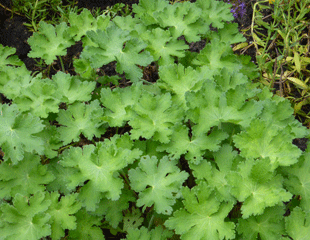
Rather than dead heading, some plants are better cut back close to the ground. This will make the plant produce fresh foliage and sometimes a later flush of flowers. This method is ideal for plants whose foliage looks a bit tired and tatty as the summer progresses. Plants suitable to be cut back hard are Alchemilla mollis, Geranium, Stachys, and Heuchera.
The Geranium in the image was looking brown and tatty. I cut back almost to the ground, and here it is a couple of weeks later having regrown its foliage into a nice lush plant. This applies equally to the foliage on Alchemilla mollis which can look really scruffy by late June or July and the key is to cut it back to the ground and it will grow back with lovely fresh foliage. If you don't like looking at bare earth you can always cut it back before going on holiday.
Cut back Aubretia
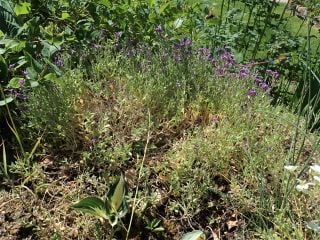
By this time of year Aubretia can look very untidy and needs cutting back. Whether to give it a light trim or a hard prune depends on the state of the Aubretia. If your Aubretia looks like the one in the image, straggly with a bald centre, it needs a hard prune.
Alternatively, if it is in good shape, quite a neat mound, it just needs a light trim. June is the time to do this after it has finished flowering and regular cutting back keeps Aubretia in shape. The Aubreita page has images of before and after pruning, or you can check out the video about cutting back Aubretia.
Biennials
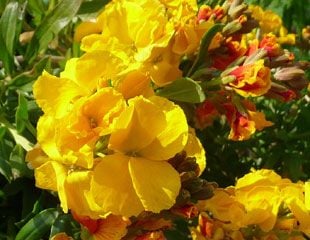
June is time to sow Biennials, a group of plants which seed and grow one year, and flower the next. A favourite in this group is Erysimum, common name Wall flower, which is easy both to germinate and grow, with the added benefit of having lovely scented flowers, a strong sweet perfume which will drift around the garden. As one of the most scented spring and early summer flowering plants, it is well worth planting Wall flowers near a seating area to enjoy the scent. They are not long-lived plants, with a tendency to go woody, but they do a long flowering period often up to 8 weeks or more.
Not all varieties are scented, some such as Erysimum allioni, Cheiranthus allioni, Erysimum 'Apricot Twist' have scent but the very popular variety often sold at garden centres, Erysimum 'Bowles's Mauve' has not, so it is best to check the label or buy when in flower so you can check. Germinate Wallflowers by sowing into seed trays and cover with a propagator or poly bag. Once seedlings are a few centimetres high, separate into small pots and grow on until sturdy plants. They should be ready to plant out in the garden where you want them to flower around late summer/August time, to get the plants get established before the winter.
Clematis care
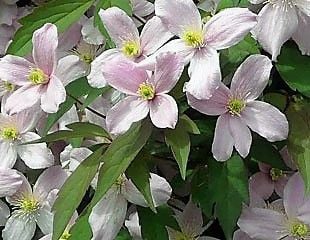
By June, Clematis montana has finished flowering. It is one of the few Clematis which does not require pruning, but it is vigorous. If it has grown too large and outgrown its allotted space, after flowering is the time to prune it back to a more manageable size. The fact that the C. montana does not require pruning makes it easier to grow. Some C. Montanas are scented, C. montana 'elizabeth' illustrated right which is vanilla scented.
More information about growing and pruning Clematis and a link to Pinterest illustrating some of the many varieties to help you choose a Clematis suitable for your garden.
What to prune in June
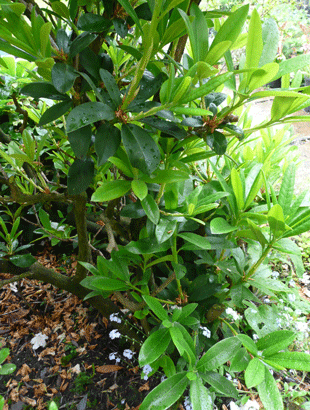
This is a safe time to prune shrubs which have already flowered, or may have flowered depending on the aspect of your garden, such as Spiraea, Choisya, Camellia, Deutzia, Philadelphus. Prune to reduce size, take out weedy branches, and to reduce leading shoots to make the shrub more bushy. I also prune at the bottom of the shrub to lift the branch canopy to allow more light and air for the plants growing around the shrub.
If needed, you can also hard prune Rhododendrons after flowering which could be May, June or July depending on the variety. If the shrub has grown too big, prune it back. It will look very bare and sorry for itself but after a few months will re grow. The shrub in the image left had grown over a path and was cut back hard to bare wood in parts. The light green is the new growth has come back very strong and already covered the pruned area. If you are renovating, it is a good idea to do this over a period of 2-3 years, cutting back a bit each year. If you are dead heading Rhododendrons, take care do not remove the embryo buds behind.
June in the Veg plot
The garden is frost free by June, which means it is safe to plant out all remaining veg. Plant out Peas, Beans of all types, salad crops, rocket, carrots, everything not yet planted out including the more tender of crops such as courgettes, squashes, cucumbers, French beans and Tomatoes, provided your garden offers shelter for the more tender crops.
All types of beans can be planted out now and also seeded directly into the veg plot for later crops. Beans and Peas all have different growing requirements check out which you need before planting.
To avoid gluts, remember that plants which are seeded or planted together, will produce fruit together, i.e. all at the same time which will produce a glut. It is better to sow and plant regularly, and easy to remember the rule of thumb is to plant every fortnight. Keep sowing and planting each fortnight until late in the season, depending on the vegetable. Seed packets will give a guide for last planting dates but always adjust dates by your garden aspect. The South has a longer growing season than the North of England. Some veg grow more quickly and can be sown again late in the season, such as radish and lettuces others, for example squash need the whole season to come to fruit and are usually sown at the beginning of the year.
Not all beans are the same
We think of Broad Beans, French and Runner beans as much the same along with Peas. In part this is correct, but they do have slightly different growing requirements in terms of support.
In short, Runners and French Beans go very tall and need a tall wigwam structure of canes or large Twigs which they will climb up as they are self clinging.
Peas need a net to scramble up.
Broad beans will not climb or scramble but need supports to stop them flopping over. The video illustrates this.
Weeds v seedlings
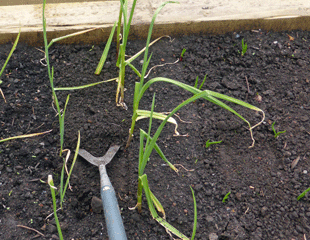
Whatever you are planting, there will be weeds. It is a good idea when planting young veg, or sowing seeds, to do it in straight lines so you can tell weeds from seeds, and about a hoe width apart.
Weeds don't grow in straight lines so you can tell which are the baby plants/small seedlings and which are the weeds. The easiest way to get rid of the weed seedlings is to hoe them off on a dry day. Using a sharp hoe run over the ground breaking up the tiny weed seedlings. This is so much easier if you can get a hoe in the space. Illustrated left is hoeing between rows of garlic and onion. The onions and garlic were planted in straight lines a hoe's width apart, which is a good tip for whatever you are planting.
Watch out for Pigeons
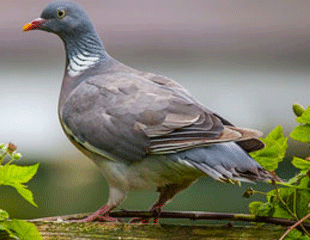
Pigeons rarely sleep, or that's how it seems to me and they love Brassica munching away at the new growth until they are too fat to fly and just waddle off. The only way to prevent this is to physically protect the young plants with mesh supported by a frame otherwise you are growing pigeon food. You will also need to net strawberries and other soft fruit if you want to enjoy the crop. Pigeons love to peck at the new growth on onions and garlic, which causes the newly planted onions to be lifted out of the soil. The birds pick up the shoot which is just above the soil, and lift up the onion which you may find scattered around and will need replanting.
Check potatoes
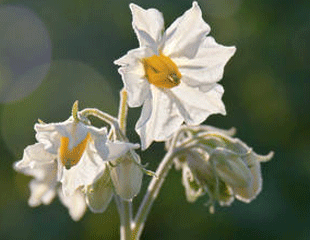
If you are growing potatoes and there is a dry spell, water regularly and earth up, both are important for a good crop as they help to form more potatoes as the season goes on. For tips and advice on growing potatoes including how to earth them up. Depending on the weather and planting times, first earlies, and in some areas second earlies, will be ready in June.
How to know if the Potatoes are ready?
Firstly, have they flowered? The flowers look like the image on the right. Potatoes will not be ready until after flowering and the best way to check what's happening beneath the soil is by gently scraping away the earth and see what you find, if they are too small, cover up and try again in a couple of weeks. The main disease of potatoes is blight, which can be difficult: advice on how to deal with Potato blight.
June plant out tender vegetables and herbs
By June it is safe to plant out the more tender vegetables as the risk of frost has passed. Courgettes and French beans both hate the cold which is why it is best to plant them out later. Later in June the first small courgettes will be ready for picking and they are at their very best when tender and small. Courgettes are prone to mildew, which you can see on the leaves as white marks. This can occur if it's dry and often occurs later in season. To minimise, feed and remove effected leaves.
It is also warm enough to sow the more tender herbs, such as Basil in pots for use throughout the summer. Basil likes it warm and on the dry side so care with watering. They are frost tender plants, so remember to bring indoors later in the year. If you like Stir-fries Thai Basil is easy to grow; it has a lovely flavour and makes a great pot plant for the patio.
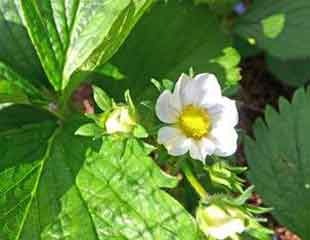
looking after Strawberries
Strawberries are usually flowering well at the end of May and early June and fruit will follow shortly. Birds love Strawberries and to preserve the crop it's necessary to cover with a net.
Another great fan of strawberries is the squirrel, and here's the evidence. What's been eating my strawberries ? and what's still eating my strawberries!
Protect with a sturdy cage using bamboo canes covered with a net. The videos show why you have to make it strong, and weight down the net if you want to keep the strawberries for you. Tips on how to make a simple fruit cage.
Early in the season remove the strawberry runners.
What to do with tomatoes in June
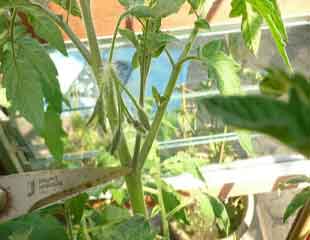
June is a busy time growing Tomatoes; they need feeding, watering, and the side shoots removing regularly. The first (and possibly the second) sets of flowers will appear, which is a signal to start feeding. With tomatoes, to get the best flavour, it is essential to feed and water regularly. Irregular watering can produce tough or skins and impair flavour. Also essential to keep removing the side shoots from cordon tomatoes, see image left. More tips about growing tomatoes follow the link. Video: How to remove side shoots from tomatoes
"Success with Tomatoes" by the Sunday Gardener has all the best tips for growing tomatoes.
Tomato care in June
As Tomatoes start to up on more growth, they need attention. This short video has some tips and advice about growing Tomatoes in June, taking offside shoots, re potting, watering and feeding.
It also looks at growing strawberries in hanging baskets
Thinning Fruit
Fruit is thinned to improve the quality of the remaining fruit and this is usually done in June, after the "June drop" which is when the tree naturally sheds some fruit but not enough. By thinning further the quality is improved, branches are not over loaded, and healthier fruit left. The suggested thinning is:
Apples cookers thin to one fruit every 15-23 cms
Apples desert one or two fruits every 10-15cms
Pears 2/3 fruits per cluster about 10-15cms
Plums one every 5-8cms or pairs every 15cms
Peaches one every 10 cms when very small (hazelnut size) and again one every 20-25cms when larger (walnut size
Nectarines one very 15cms ( walnut size)
